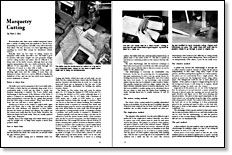
Synopsis: There are many cutting tools and methods to choose from when cutting marquetry. A knife is good for pictures with many straight cuts and geometric designs and for cutting borders and meters. A saw allows tight turns and the cutting of more than one thickness at a time. Both have limitations, however. In this article, Peter L. Rose discusses those as he explains how to choose tools and how to practice different cutting methods. He details the single-piece method, the window method, the pad method, and the double-bevel-cut method.
Woodworkers who have never tackled marquetry before have a variety of cutting tools and methods to choose from. Depending on one’s patience and skill, some will work better than others. The aim, of course, is to have tight-fitting joints requiring no wood filler except for intentional esthetic reasons.
Basically, there are two ways of cutting veneers for marquetry—with a knife, and with a saw. The knife is good for pictures with many straight cuts and geometric designs and for cutting borders and miters. But it’s difficult to cut sharp turns on the harder veneers, although there are some superior marquetarians who use a knife exclusively. Also it’s difficult, if not impossible, to cut neatly through two thicknesses of veneer at a time with a knife.
The saw overcomes the disadvantages of the knife by allowing tight turns and the cutting of more than one thickness at a time. But it, too, can be difficult to handle, has limitations of size, and can run into much more expense if power equipment is chosen.
Knives to choose from
The knife most used in marquetry is the X-acto knife with a #11 blade, a blade that has an extremely sharp point. It is a comfortable knife to hold and the blade is sturdy, but frequent sharpening is required. The X-acto knife’s main disadvantage is that because of the thickness of the blade, it makes a V-shaped cut, spreading the veneer apart at the top. Many marquetarians overcome this by cutting their pictures from the back using a reverse pattern. When seen from the front, the cuts will have a much tighter fit.
Another good choice is the scalpel or surgical knife, again with a #11 blade. This is a flat, slim knife that uses blades about the same thickness and sharpness as razor blades. Because the blades are thinner and sharper, the scalpel cuts the veneer more easily than the X-acto knife. However, the blades are fragile and break easily. They are usually replaced rather than sharpened.
Finally, there is the single-edge razor blade which is good only for straight cuts, as sharp turns require a much more pointed blade. Saws to choose from The main point to remember about saws for marquetry is that the thicker the blade, the cruder the cut and the wider the gap between pieces. Thus the popular coping saw is definitely ruled out.
From Fine Woodworking #1
For the full article, download the PDF below:
Fine Woodworking Recommended Products

DeWalt 735X Planer

Whiteside 9500 Solid Brass Router Inlay Router Bit Set

Ridgid R4331 Planer






















Log in or create an account to post a comment.
Sign up Log in